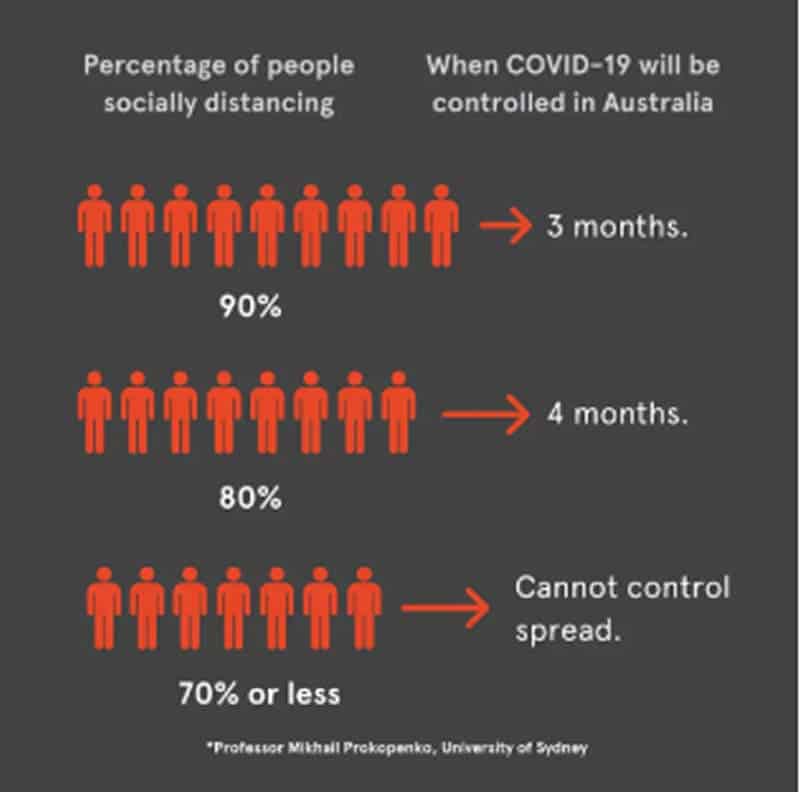Strong social distancing measures can curb the pandemic in 13 weeks or so — but only if 80% of the people do it, a new study claims. If 70% or less do it, the pandemic may not be curbed.
The numbers were calculated for Australia’s demographics, but they carry important lessons for the entire world, and the numbers are likely not that different for other countries.

A new study carried out by Australian researchers analyzed how effective different levels of social distancing are in limiting the spread of COVID-19. While the exact figures are specific for Australia, the general findings should carry over for most if not all countries on the planet: if social distancing isn’t practiced by the vast majority of the population, then it can all be for naught.
According to the findings, early intervention is key: the sooner you impose a quarantine, the more you delay the peak of the disease, the more lives medical workers can save.
“There’s good reason for imposing tough measures early on. The longer we delay the peak, the more time our healthcare system has to prepare for it by accessing more resources such as ICU beds, ventilators, antivirals and trained health workers,” said Professor Mikhail Prokopenko from the University of Sydney.
This approach is basically a trade-off. We save more lives, but this means we impose the quarantine for longer — essentially, we are temporarily offering some of our civil liberties in exchange. But there’s a catch.
When it comes to this type of quarantine, it’s basically all or nothing: either enough people do it, in which case we can curb the disease and move on from there, or if not enough people comply, our curbing efforts will not be very effective.
When it comes to actual figures, over 3 in 4 people need to comply in order to have some effectiveness. The more people do it, the quicker it can be over with.
“If we want to control the spread of COVID-19 – rather than letting the disease control us – at least eighty percent of the Australian population must comply with strict social distancing measures for at least four months,” said Professor Mikhail Prokopenko.
“Conversely, if less than seventy percent of the population is adopting social distancing measures, we cannot suppress the spread of the pandemic and any social distancing could be a fruitless effort,” he said.
Another aspect to consider is compliance. There’s no going around it, but maintaining a quarantine for weeks or months will be increasingly difficult as time passes. Some countries have tried to opt for a compromise: install a laxer quarantine that is easier to comply with.
According to the study, that just doesn’t work.
“There is a clear trade off – stricter measures imposed earlier would reduce how long our lives are impacted by this disease. On the contrary, laxer protocols could mean a longer, more drawn out and ineffective struggle against COVID-19,” Prokopenko added.
However, the model also shows that some measures aren’t as effective as others. For instance, school closure only brings decisive benefits when coupled with a high level of social distancing compliance. In other words, if people aren’t distancing in the first place, closing schools doesn’t do much. The researchers also found that while school closures had the potential to compensate for about 10% of a lack of social distancing compliance, they only delayed the peak of the pandemic by two weeks.
It’s important to note that the model used demographic inputs from Australia. Contact rates within different countries with different economies (and cultures) will also be different — but the trend is almost certainly the same.
It may not be 70% or 80%, but there is an important turning point in social distancing compliance. That may be higher or lower depending on different areas’ demographics, but if not enough people do it, it’s not effective.
Understandably, policymakers will try to weight out the health impacts of the outbreak against social and economic ramifications and may be reluctant to impose strict measures. Understanding where the turning point in transmission lies for each country or area is vital in establishing the specifics of the quarantine and for further devising long-term plans for dealing with the disease.
Curbing the pandemic is the top priority at the moment — but it’s far from being our only fight; it’s just the beginning. After the number of cases is reduced, we will need to find a way to reduce social distancing while not risking an even worse second wave of infections.
The study has been published in the pre-print server arXiv.









